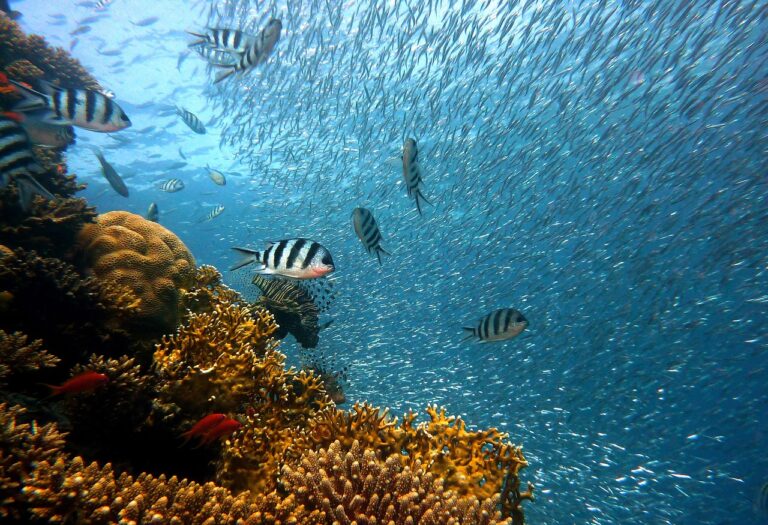What role do the oceans play in regulating the climate and supporting life on Earth?

The world’s oceans cover most of the Earth’s surface and represent about 95% of the planet’s biosphere. They contribute to climate regulation by absorbing over a quarter of human-caused carbon dioxide (CO2) emissions and around 90% of excess heat. They are also an important source of animal protein for billions of people and of associated livelihoods in what is known as the blue economy, as well as providing a crucial wildlife habitat, with ocean biodiversity being much higher than that found on land.
How do the oceans remove CO2 from the atmosphere?
The oceans are a major component of the climate system. They have played the principal role in the climatic balance that the planet has experienced over the last few thousand years. Their role in regulating climate involves taking up heat and redistributing it across the globe, increasing atmospheric humidity, and buffering (taking up and storing) large quantities of CO2 from the atmosphere. The oceans are by far the largest active carbon reservoir on the planet, storing about 38,000 billion tonnes of carbon. By comparison, this is over 28 times more than the quantity of carbon stored by land vegetation and atmosphere combined.
Most of this carbon is stored at deep ocean levels via two distinctive routes.
In the first route, CO2 in colder high latitude waters is dissolved. Because these cold waters are heavier than the warm waters coming from the tropics, they sink, bringing this dissolved CO2 down into the deep ocean. Most of the carbon is stored in the oceans through this route, which is technically called the solubility (carbon) pump.
The second route is referred to as the biological (carbon) pump and it is much more complex, involving a range of biological, chemical, physical and geological (so-called ‘biogeochemical’) factors. It can be roughly summarised as follows: microscopic plants called phytoplankton reproduce on the ocean’s sunlit surface waters, converting dissolved CO2 into around 50 billion (net) tonnes of organic matter every year, while producing oxygen (O2) as a by-product. When these micro-plants die, they undergo a series of biogeochemical processes (which involves fragmentation and aggregation) that transform the plants into particulate organic matter compounds, which start to sink down from the surface. These compounds pass through the intermediate-depth waters, often referred as the ocean’s ‘twilight zone’. This is the region of the open ocean covering depths from 100–200m to about 1,000m, where light only partially penetrates, below the sunlit surface waters, but above the aphotic (unlit), cold, deep waters. This zone is crucial in determining how much carbon will reach the deep ocean and therefore how long carbon will remain in the oceans. Here, these once micro-plants (now particulate organic carbon compounds) serve as food for other organisms including bacteria, which convert much of the organic carbon matter back into CO2.
The remaining organic matter survives its downward journey for longer, eventually reaching the deep ocean before being reconverted into CO2. However, because the ocean’s circulation at these depths is much slower, it takes much longer – hundreds to thousands of years – for this carbon to reach the surface and be released back into the atmosphere.
The oceans’ long-term role in redistributing CO2 from the atmosphere to the oceans
The emergence of the oceans over 4 billion years ago transformed how CO2 is distributed over the Earth’s surface. As the oceans dissolved and stored CO2, the gas went from being a major component of the Earth’s atmosphere to a trace gas, thereby changing the atmosphere’s composition and climate. In turn, carbon became abundant in the ocean, enabling the production of new micro-plants via photosynthesis (whenever light and nutrients such as iron and nitrogen are sufficiently present), starting the biological pump (see above), which further enhanced the oceans’ carbon storage. In fact, the biological pump is estimated to have further lowered atmospheric CO2 concentration by more than 50% of what it would have been otherwise.
Since the Industrial Revolution began in the mid-19th century, the oceans alone have stored an estimated 26% of manmade, or anthropogenic, CO2 emissions via a combination of physical and biogeochemical mechanisms. Carbon transformation via biogeochemistry has also transformed the oceans into a vital source of at least half of the oxygen (a by-product of photosynthesis) in the atmosphere, which enables terrestrial life to thrive. As such, the ocean can be considered the lungs of planet Earth.
The ocean is also crucial in controlling atmospheric temperatures: without the ocean and its diversity of service provision, Earth’s maximum temperature would exceed 100°C, and the average surface temperature, which is currently around 15°C, would instead be around 50°C. Unfortunately, the excess heat absorbed by the oceans has increased their mean temperature in recent decades and this warming is contributing to the melting of icesheets and glaciers as the oceans redistribute heat towards the poles – and in turn, to sea level rise. (This is detailed further in our explainer on the oceans and climate change.)
What threats do the oceans face?
The oceans are under threat from climate change which has led to warming and acidification, causing biodiversity loss and threatening food provision. Moreover, there is new evidence suggesting that with continued warming and CO2 emissions, the ocean’s capacity to absorb yet more CO2 in the future could stall, and even reverse. (Our explainer on the oceans and climate change explain these issues further.) The oceans are also threatened by over-fishing, coastal habitat destruction (especially of coral reefs and mangroves) and pollution, including from run-off from rivers polluted with industrial and agricultural waste.
This Explainer was written by Francisco de Melo Viríssimo and Elizabeth Robinson.

